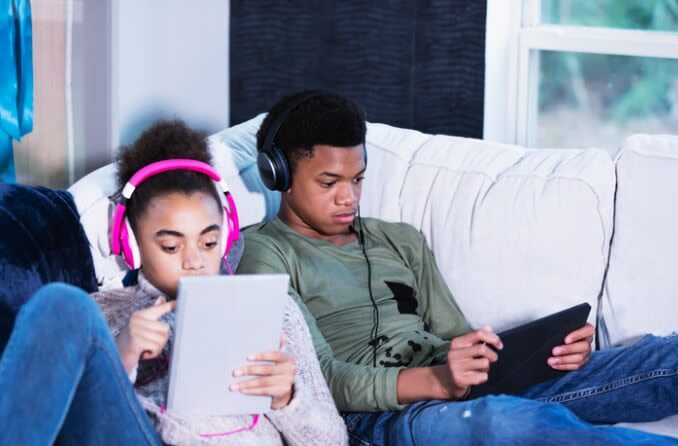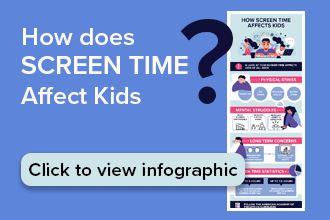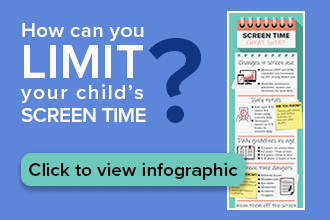The positive effects of reducing screen time

Can decreased screen time cure or reduce myopia?
Much like healthy eating and exercise, reducing screen time has many benefits. An important vision benefit is that reduced screen time may help to slow down myopia progression. However, it has not been shown to cure or reduce myopia that has already developed.
Rates of screen time and myopia have risen
When you add it up, nearly everyone is spending a good chunk of their day staring at a screen.
American children between the ages of 8 and 12 years spend an average of 4 to 6 hours a day looking at screens. Teenagers spend up to 9 hours a day looking at a screen, and adults spend up to 11 hours a day.
The number of Americans with myopia has increased since 1971, when only about 25% of Americans were nearsighted. Today, myopia affects more than 41% of Americans.
Spending many consecutive hours doing near work such as looking at a screen is stressful for the eyes. Scientists have begun to wonder if there is a connection with the increasing rates of myopia and increased screen time. A great deal of research has gone into investigating this connection.
Does screen time have a link to myopia?
No studies to date have demonstrated that reduced screen time can cure or reduce myopia that has already developed.
Several studies have found that spending many hours on screen time is associated with an increased risk of myopia development. However, other studies have been inconclusive.
To better understand this, a 2021 meta-analysis looked at 33 research articles. It analyzed the link between myopia development and smart devices such as phones and tablets.
The conclusion was that the use of smart devices and computers is associated with an increased risk of myopia development.
How much screen time is too much?
It’s hard to avoid screen time when you work on a computer for your job and school. You stay in touch with friends via texting and social media. You shop online. You relax by watching videos and browsing the internet.
The number of screen time hours that young children are logging on digital devices has alarmed childhood experts.
Leading authorities on child development recommend that toddlers should only watch educational programs as a way to spend time with a caregiver. Videos should not be used as an alternative babysitter.
Children ages 2 to 5 years old should get less than 1 hour of screen time on weekdays and only up to 3 hours on weekend days.
For ages 6 and up, experts recommend that digital devices should be balanced by healthy habits and routines as appropriate. This applies to teens and adults as well.
The American Academy of Child and Adolescent Psychiatry (AACAP) also recommends that during family meals and outings, screens should be put away. You should avoid electronic devices in the bedroom, and turn off your screens at least half an hour before bedtime.
READ MORE: How much screen time is okay for my child?
How much screen time do eye doctors recommend?
Many experts have already begun to advise against excessive screen time as a way to reduce the risk of myopia and myopia progression.
If you already have myopia, taking steps to prevent it from progressing is important for long-term eye health. High myopia increases the risk of pathological myopia and other vision-threatening conditions.
According to a 2019 study, if myopia is slowed by 1 diopter in childhood, the risk of pathological myopia is lowered by 40%. In other words, slowing myopia progression is very important for lowering the risk of visual impairment in later life.
What can I do to reduce the risk of myopia?
A person’s risk of myopia involves many factors. Some of these factors, including heredity, are beyond your control.
The good news is that vision scientists believe there is something you can easily do that can decrease myopia risk. It's as simple as spending more time outside during the day. Scientists have found that, in addition to decreasing screen time, spending more time outdoors may reduce the risk of myopia development.
You can improve your vision health by finding healthier ways to spend your free time. Taking a walk outside instead of watching a video may multiply the benefits of reducing screen time.
A 2017 study found that children who spent little time outdoors during the day were found to have a 5-times higher risk of developing myopia. Those who spent little time outdoors and also spent a lot of time focusing up close were found to have a 16-times higher risk of myopia development.
These findings emphasize the negative effect of extended near work. They also highlight the positive vision impact of spending time outside.
A 2020 literature review analyzed 12 studies on myopia development from the past 10 years representing over 33,000 participants. This analysis concluded that spending time outside during the day is an effective strategy for decreasing a child’s risk of myopia progression.
Be screen-smart
The key takeaway is that decreasing screen time will not reduce myopia that has already developed. But reduced screen time is associated with a decreased risk of myopia progression. This is especially true when coupled with increased outdoor time.
When you do have to spend time at a screen, incorporate some of these strategies to decrease eye strain:
Take visual breaks — An easy way to remember this is the 20-20-20 rule (every 20 minutes, for 20 seconds, look at something at least 20 feet away).
Remember to blink — When looking at a screen, your blink rate decreases significantly. This can lead to fluctuating vision and dry eyes.
Apply artificial tears or warm compresses — These therapies will soothe and refresh your eyes.
Make yourself comfortable— Adjust the height of your desk, chair and screen to maintain comfortable posture.
Don’t sit too close to the screen — The closer you sit, the harder your eyes have to work to keep your vision clear.
Prevent glare — Lighting should be directed away from your eyes and dimmed so it’s not too harsh.
Make your screen vision-friendly — Adjust font and background colors. Use glare-reducing filters and wear computer glasses or blue-light-blocking glasses.
Be screen-smart. Decrease screen time. Increase outdoor activities. You will be rewarded with long-term benefits for your eyes, health and overall well-being.
READ NEXT: Digital Detox: Challenge your kid to try 24 hours with screen time
Screen time and children. American Academy of Child and Adolescent Psychiatry. February 2020.
How much screen time is too much? Scripps. February 2019.
Myopia: A close look at efforts to turn back a growing problem. National Eye Institute. October 2017.
Association between digital smart device use and myopia: a systematic review and meta-analysis . The Lancet Digital Health. December 2021.
Media use in school-aged children and adolescents. American Academy of Pediatrics. November 2016.
Current trends among pediatric ophthalmologists to decrease myopia progression—an international perspective. Graefe's Archive for Clinical and Experimental Ophthalmology. August 2018.
IMI pathologic myopia. Investigative Ophthalmology and Visual Science. May 2021.
Myopia Control: Why Each Diopter Matters. Optometry and Vision Science. June 2019.
Preventing myopia. Dtsch Arztebl Int. 2017.
The role of time exposed to outdoor light for myopia prevalence and progression. Clinical Ophthalmology. July 2020.
Does more screen time put your child’s eyes at risk? Duke Health. September 2020.
Page published on Wednesday, April 27, 2022
Page updated on Tuesday, April 26, 2022








